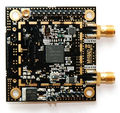Myriad-RF 1: Difference between revisions
Ghalfacree (talk | contribs) m (Corrected typo.) |
Ghalfacree (talk | contribs) (Added licensing information.) |
||
| Line 49: | Line 49: | ||
File:MyriadRF-Schematics-6.png|Power supply | File:MyriadRF-Schematics-6.png|Power supply | ||
</gallery> | </gallery> | ||
===Licensing=== | |||
====Hardware==== | |||
The hardware designs are licensed under a [https://creativecommons.org/licenses/by/3.0/ Creative Commons Attribution 3.0 Unported] licence. | |||
Note: The Myriad-RF 1 and DE0-Nano Interface hardware designs were initially published under the [https://creativecommons.org/licenses/by-sa/3.0/ Creative Commons Attribution-ShareAlike 3.0 Unported] licence. As of 30th September 2013 these have been re-licensed under the more permissive Creative Commons Attribution 3.0 Unported licence. | |||
====Firmware==== | |||
For details of firmware licensing please see the associated COPYING file(s), available in the [https://github.com/myriadrf/reference-development-kit GitHub repository]. | |||
===See Also=== | ===See Also=== | ||
Revision as of 13:42, 24 July 2015
About
The Myriad–RF 1 board is a multi-band, multi-standard RF module, based on the LMS6002D transceiver IC by Lime Microsystems. It has one RF broadband output, one RF broadband input with digital baseband interface, established via a standard Hirose FX10A-80P connector. The board also provides the user with pin headers for power supply, reference clock, analogue input/output and Serial Peripheral Interface (SPI) connections. It contains everything needed for it to be connected to baseband (BB) chipsets, Field-Programmable Gate Arrays (FPGAs), or to run independently in an standalone mode.
The Myriad-RF 1 board enables developers implement their products for a wide variety of wireless communication applications quickly and efficiently, given the flexibility of the solution. In addition, the designer can make use of the freely available ready-made board implementation, modify and manufacture to accelerate the development time.
Images
-
Myriad-RF 1, top
-
Myriad-RF 1 block diagram
Specifications
| Transceiver | LMS6002D |
| RF Bandwidth (BW) | 300 MHz to 3800 MHz |
| Baseband Bandwdth (BW) | Programmable (16 selections:; 0.75 – 14 MHz, Bypass mode |
| RF Module Control | Via Serial Peripheral Interface (SPI) |
| Analogue Inputs | I/Q differential analogue input for transmitter |
| Analogue Outputs | I/Q differential analogue output from receiver |
| Reference Clock Frequency | 23 – 41 MHz |
| Input Voltage | 5 V(recommended) |
Connections
The Myriad-RF 1 board can be used as a standalone board or in conjunction with the DE0-Nano Interface Board or Zipper Interface Board. The analogue differential IQ interface is also available directly on the Myriad-RF 1 board, along with RF connections. A full list of available connections is available on the page Myriad-RF 1 Connections.
Schematics
-
RF circuits
-
Analogue circuits
-
Clocks, RF FE
-
Connectors
-
Digital circuits
-
Power supply
Licensing
Hardware
The hardware designs are licensed under a Creative Commons Attribution 3.0 Unported licence. Note: The Myriad-RF 1 and DE0-Nano Interface hardware designs were initially published under the Creative Commons Attribution-ShareAlike 3.0 Unported licence. As of 30th September 2013 these have been re-licensed under the more permissive Creative Commons Attribution 3.0 Unported licence.
Firmware
For details of firmware licensing please see the associated COPYING file(s), available in the GitHub repository.







